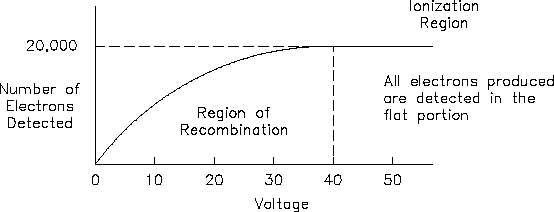IONIZATION CHAMBER
Radiation Detectors
When the voltage is increased, the free electrons are more strongly attracted to the positive plate.
They will move toward the positive plate more quickly and will have less opportunity to
recombine with the positive ions. Figure 15 shows a plot of the number of electrons measured
by the ammeter as a function of applied voltage.
Figure 15 Recombination and Ionization Regions
At zero voltage, no attraction of electrons between the plates occurs. The electrons will
eventually recombine, so there is no current flow. As the applied voltage is increased, the
positive plate will begin to attract free electrons more strongly, and a higher percentage will reach
the positive plate. As the voltage is increased further, a point will be reached in which all of the
electrons produced in the chamber will reach the positive plate. Any further increase in voltage
has no effect on the number of electrons collected.
The simple ionization chamber shown in Figure 14 can also be utilized for the detection of
gamma rays. Since the ammeter is sensitive only to electrons, gamma rays must interact with
the atoms in air between the plates to release electrons. The gamma rays interact by compton
scattering, photoelectric effect, or pair production. Each of these interactions causes some, or all,
of the energy of the incident gamma rays to be converted into the kinetic energy of the ejected
electrons. The ejected electrons move at very high speeds and cause other electrons to be ejected
from their atoms. All of these electrons can be collected by the positively charged plate and
measured by the ammeter.
IC-06
Page 30
Rev. 0


